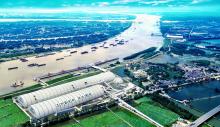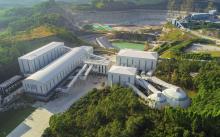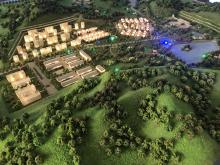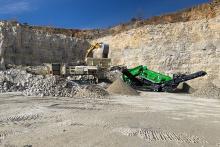
The commercial potential for Western aggregates crushing and screening plant manufacturers in China is enormous. Just ask Martin Conway, Terex Materials Processing's (Terex MP) sales director in the country. Since 2019, Conway has been a key figure in Terex MP brand Powerscreen's impressive ascent in the over 20 billion tonnes a year Chinese aggregates market.
A new manufacturing facility in the Jiading district of Shanghai is, says Conway, huge for Powerscreen's long-term growth plans in the domestic China market. The 18,000m² facility allows the brand to begin production in China, accelerating manufacturing plans by around two years. The Jiading facility will also expedite Powerscreen’s growth in China without impacting production volumes at its other global facilities.
A dedicated team from Northern Ireland is overseeing the production scale-up in China, ensuring processes are to the same robust standard of Powerscreen's manufacturing centre of excellence in Dungannon, County Tyrone. Powerscreen equipment is onsite for the training of the China factory team, and the first locally produced machines will come off the line early in the new year. Jiading facility-produced plants will initially feature models from Powerscreen’s comprehensive range of jaw and impactor crushers and its Chieftain and Warrior range of screens.
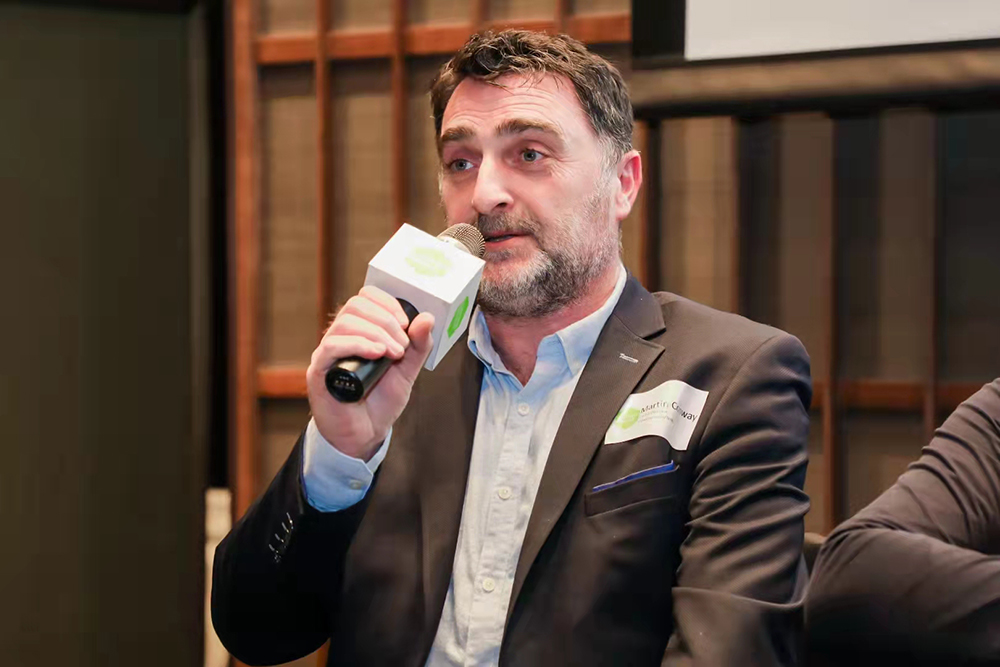
Terex MP’s commercial team is based in Shanghai, and the new Jiading facility is less than 200 kilometres from Terex Aerial Work Platforms’ (Terex MP) Genie brand facility in Changzhou.
"The significance of the new factory cannot be understated. Showing a commitment to the Chinese market is incredibly important to Chinese customers. They've seen international companies come and go. China, for us, is an incredibly important market and we are fully committed to a long-term future there.
"Meeting with our dealers recently, a big thing that kept coming up was the factory investment. It means that when they invest in personnel and Powerscreen equipment and marketing, they know we are here long term.
"We are having an open day at the Jiading factory in March next year. Mr Hu [Youyi, president of China Aggregates Association] and Professor Chen from the China Waste Recycling Commission (CWRC) will be invited. I've got a very good working relationship with Professor Chen and have been to several CWRC events. Mr Hu realises the significance of Powerscreen investing in a Chinese facility", said Conway.
Powerscreen first entered China in 2016 in response to huge government investment in infrastructure and legislation supporting the use of recycled materials. Since then, the brand has continued to build a growing market presence through its China sales and service team, building its distribution network, attending industry exhibitions, and hosting customers through dealer open days.
"Before I arrived in China, Powerscreen had decided to make a major investment in parts and aftermarket support. It is a critical part of our business. When customers spend on quality equipment, they want genuine parts replacement from the manufacturer – and now the new factory will supplement our supplies and customer support," continued Conway.
Emphasising the vast size of the Chinese aggregates market, which generates around 1,000 crushing and screening plant sales a year, Conway says: "There were 25.2 billion tonnes of aggregates produced in China in 2020, according to figures I saw earlier this year from the China Construction Machinery Association (CCMA) figures. That production level was to help kick-start construction again once the coronavirus was back under control, with large infrastructure investment announced and money freed up. I think it was the biggest year ever in terms of aggregates production.
"The eastern part of China, from Beijing down to Guangdong, is typically the biggest market, as that's where the financial hubs and export markets are. There is a lot of investment in infrastructure, in high-speed railways and new highways. However, the Chinese government is also investing in traditionally poorer areas.

"The types of machines appropriate for each area of China varies. The market is very provincial. If you're in Shanghai, Beijing, Guangzhou, and Shenzhen in Guangdong, the big eastern cities, it is very much focused on recycling. Shanghai and Beijing, for instance, have no natural aggregates. Guangzhou has only a little, and Shenzhen concentrates on recycling concrete roads and reusing them in concrete-asphalt mixes. The Chinese government also has incentives for 41 cities to use more recycled aggregates in construction works.
"There are provinces that are impactor and scalper applications only, like in Sichuan, which is limestone quarry territory. In other provinces, like in Guangdong outside the two major cities, there's a lot of granite. That means it's all jaw-cone-screen purchases. If you go to Zhejiang, right beside Shanghai, the north of the province is mostly impactors, the south of the province is typically jaw-cone-screen."
I'm curious to know who Conway sees as Powerscreen's biggest competitors in China. "Like any market there are many competitors at play in China, ranging from locally made equipment by Chinese manufacturers to international brands we compete with in other global markets.
"However, it’s important to remember that in China, the mobile crushing and screening plant industry is only about 11 years old. A lot of our sales team here have been involved since the beginning. Salespeople within the industry know who Powerscreen are, respect our reputation and are keen to work with us. Having the right team in place is a huge asset as we set ourselves apart from the competition in China, and the Jiading facility will further contribute to this.”
Conway says that while vast quantities of aggregates required for the New Silk Road - a US$900bn project to recreate the ancient road and maritime trade route that once ran between China and the West - have created attractive commercial opportunities for Powerscreen and other Western and Chinese crushing and screening plant manufacturers, there are several other ongoing aggregates-hungry Chinese infrastructure megaprojects. They include a new high-speed railway between Qinghai and Tibet and a new superhighway project linking Sichuan and Tibet.
"Just one stretch of the Sichuan-Tibet superhighway is 1,000 kilometres, and around 900 kilometres of that is tunnels. You've then got the stations along the Qinghai-Tibet high-speed railway route, on top of the laying of the tracks. Cities are also investing in local roads to the new stations.

"We've got contractor customers working on the Sichuan-Tibet superhighway. Part of it was at the epicentre of an earthquake that split the highway in two! It's delayed work a few months.
As previously reported in ABI, China's foundation for the major adoption of greener mining (quarrying) and linked environmental commerce and tourism has been laid by the Chinese government's closure of tens of thousands of smaller environmentally harmful quarries across the vast country. This, coupled with a more diligent approach to granting new quarry licences, based on meeting tougher green production and site restoration criteria, has reduced the number of Chinese quarries by around 40%, from more than 300,000 to 180,000. Most of the remaining are larger quarries that are demonstrating or are willing to prove their commitment to more ecologically sustainable aggregates production.
I ask Conway for his take on China's green mining revolution. "We and our dealers are heavily involved in the green mining switch. I have visited many of the sites that are looking to be part of it.
"A few months ago, we gave a presentation to the municipal government in Chongqing about how to recover a major green mine. When I say a major green mine, I mean an area that's twice the size of a big quarry in the UK or Ireland.
"Green mining is part of the Chinese government's latest Five-Year Plan [2021-2025]. It is good to know what the government is going to invest in as what is promised will typically always happen.”
Looking to the future, Conway thinks technology advances will continue along the environmental route. "Many small producers in China would use stationary electric equipment [if it was more readily available]. Greater plant electrification is where the Chinese market is heading and developing our electric plant range is one of our key focuses.
“2022 will be incredibly significant for us in terms of the electrification, as we aim to introduce four models to deal with the demand from customers who need the benefit of mobility, but also the necessity of lower emissions on-site. The environmental focus from the government on emissions, added to safe operation within tunnel projects, has provided the opportunities to enhance our electric offering and tailor this to the wider needs of the extensive China market. We all need to be a lot more conscious of the environment and reducing carbon emissions is a major thing."
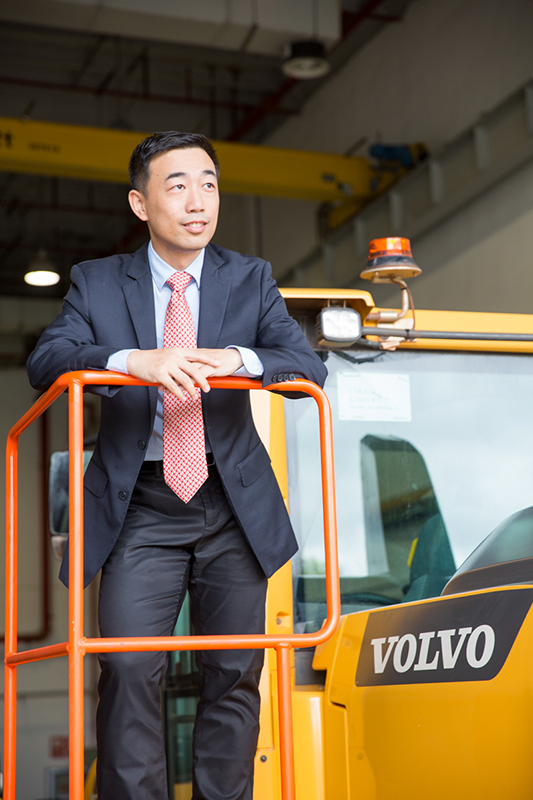
China has powered through the COVID-19 pandemic with an impressive 8% growth in aggregates demand anticipated in 2021, according to GAIN (Global Aggregates Information Network), a voluntary global coalition of aggregates associations. GAIN says there are reports of difficulty in meeting burgeoning national aggregates demand, which now amounts to 50% of global production.
Data show that as of 30 June 2021, China’s average price of manufactured sand was 103 yuan/ton (US$16.12); the average price of crushed stone was 96 yuan/ton ($15.03); the average price of natural sand was 136 yuan/ton ($21.29).
Speaking to Economic Daily and China Building Materials News, Hu Youyi, president of the China Aggregates Association (CAA), says China is in the process of developing greener and higher quality industrial working practices and output, including in the aggregates sector. “At the same time, there is a vigorous promotion of infrastructure construction, and the demand for aggregates is large,” he stresses. Hu said the closure of non-environmentally friendly aggregates production sites, while simultaneously not approving new greener sites, had led to a notable current reduction in supply to infrastructure construction projects. He added: “Outdated aggregates-production capacity has been eliminated, and non-environmentally friendly enterprises have been closed down, but it takes one to two years to build a modern aggregates-producing enterprise.”
Volvo Construction Equipment (Volvo CE) is another major Western original equipment manufacturer with a strong presence in the Chinese market.
Quoting CCMA figures, Sam Lu, head of sales support & dealer development, Volvo CE Region China, says the Chinese quarrying/mining loading and hauling machines market is set to see 14.2% year-on-year growth in 2021, with a good mix of domestic and international players doing good business. Lu says a 20% year-on-year loader and hauler unit sales increase is also anticipated in 2022, as China’s infrastructure development work picks up its already impressive pace.
“In China’s 14th five-year plan covering the period of 2021-2025, there are key projects with high demands for aggregates/quarrying machines such as the Belt & Road Initiative, Xiong’an New Area, Guangdong-Hongkong-Macao Greater Bay Area, Sichuan-Tibet Railway, and hydropower station construction in Xinjiang and Tibet,” says Lu.
Asked what Chinese quarrying and construction customers are looking for in their loaders and haulers, Lu said: “For prolonged use in challenging site conditions, reliable and durable models are needed to ensure machine uptime. Cost per ton is another critical factor. Customers can lower that cost with machines supplying high productivity, low fuel consumption and less maintenance needs.”

Lu says that to meet carbon-reduction goals and adhere to wider Chinese environmental protection policies in China, aggregates quarrying sites are now upgrading their machines to higher efficiency, lower carbon-output models.
He adds: “Digitalisation is also changing how construction and quarrying machinery OEMs like Volvo CE interact with the new generation of customers. For larger production machines that require more interaction between customer and dealer, it will be harder for buyers to make an online purchase. However, it will be easier to go digital and embrace e-commerce purchasing trends for smaller, simpler, electric compact machines that usually require less maintenance due to lower usage.”
Located in Sichuan province, Dong Sheng Construction Material Company (Dong Sheng) is one of Volvo CE’s key account customers in its Chinese aggregates business segment.
Dong Sheng has a long partnership with Volvo CE and has been using Volvo CE excavators and wheeled loaders as its main loading units.
“Starting from owning medium-size excavators, they have now expanded their fleet gradually, including our largest products such as L350H and EC950E,” explains Lu. “Dong Sheng recognised the high fuel efficiency characteristic of Volvo CE machines which has brought about significant cost saving compared with other brands.
“Another factor of Dong Sheng’s success today is that they have adopted large machines for their production, realising a higher efficiency that larger machine brings with, generating higher profits. For example, they were one of the first companies to use Volvo CE’s L250G wheeled loader in China, replacing several five ton wheeled loaders from domestic brands with one Volvo L250G. Less operator cost is realised through higher machine availability and productivity, and Dong Sheng has placed subsequent orders for several L260H and L350H wheeled loaders.”
Lu says Volvo CE will soon unveil more large excavator models such as the EC500, EC550, EC500 Hammer to meet evolving demands of aggregates-production customers. Lu notes that the new models will fill the gap between the EC480 and EC750DL, bringing higher productivity and fuel efficiency.
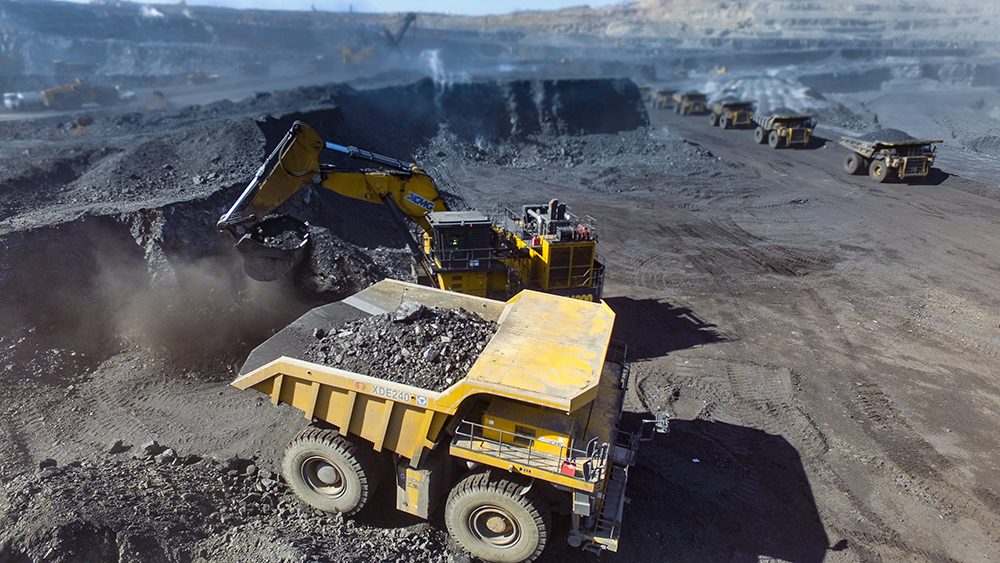
“The EC550 will come with advanced IMVT technology that brings great fuel efficiency while the hammer version models will improve second-break efficiency, ensuring durability and reliability in tough conditions.”
Chinese quarrying, mining and construction machine giant XCMG notes that China’s sand and gravel consumption experienced a long period of rapid growth to 2014, peaking at 18.69 billion tons that year, after which it entered a relatively stable period during which tonnage fluctuated between 17 and 18 billion.
“Companies participating in the competition for business within the industry originate from four major segments: the private sector, the cement sector, the hydropower sector, and the traffic construction engineering sector, of which large groups operating in cement traffic construction engineering have entered the market in recent years. Today, the sand and gravel market is characterised by high gross profits, with profit concentration remaining an issue that still needs to be tackled,” says a spokesperson for the Xuzhou, Jiangsu province, eastern China-based manufacturer.
“Resource costs vary widely by region, while the structural shortage of product is obvious. In addition, the bidding price for resources continues to hit new highs, with state-owned enterprises increasing their efforts to compete for sand and gravel resources, and non-traditional firms competing at the low end. At the same time, environmental investments continue to increase the cost pressure on all players, while unpredictable changes in policies at the local level remain a constant risk.
“The industry also faces further challenges including high logistics costs and poor logistics, as well as difficulties in the raising of financing. In developed countries, equipment that is mobile accounts for 60% of all products, whereas in China mobile equipment used for crushing has a relatively brighter market prospect due the country’s environmental protection policies.”
“At present, China's aggregates/quarrying industry needs to upgrade to reach the quality levels that are generally expected today,” said XCMG vice general manager for excavators and general manager for marketing, Zhang Fengting. “However, being able to reach those quality levels is a relative concept, which can be simply understood as neither something that seeks a high profit, nor the pursuit of a large scaling up of the business. In order to do so, one needs balanced development.”
Zhang states that green mine construction means “more than just planting flowers and grass, but the rational utilization and in-depth development of technologies, mine construction processes and resources”. He continues: “All these require companies with strength to make more reasonable and full use of these resources.

“Traditional aggregates/quarrying companies have given the general public the impression of being scattered, disorderly and, generally speaking, of poor quality. Most of them are small players, producing goods that comply with the lowest of standards and meeting those low-quality requirements under poor management. Over recent years, China has adjusted the policy for supporting the growth of the sand and gravel industry, facilitating the active engagement of large state-owned enterprises, cement producers and mining companies in the sand and gravel business. From the perspective of resource utilisation and green mine construction, the participation of the larger firms in the industry may be more helpful to the sand and gravel industry's transition to an overall higher quality level.”
Zhang notes that in 2020, XCMG Excavator teamed up with China Sha Shi Gu Liao Wang (CSSGLW) to conduct a country-wide survey of how best to raise the quality of the Chinese sand and gravel industry. To date, the survey has been completed by industry businesses in Zhejiang, Jiangxi, Guangxi, Guangdong, Sichuan and Hubei provinces, as well as in the city of Chongqing. XCMG has also assisted in the completion and release of the list of China’s Top 20 sand and gravel producers in 2020 and the 2020 Edition of the Distribution Map of the most well-known large and medium-sized sand and gravel production lines in China.
We will be keen to report on the findings of the completed XCMG-CSSGLW Chinese sand and gravel market survey in a future edition of ABI. In the meantime, the race continues to provide ever more sophisticated plant technology and linked services packages to customers in the world’s biggest aggregates market.

